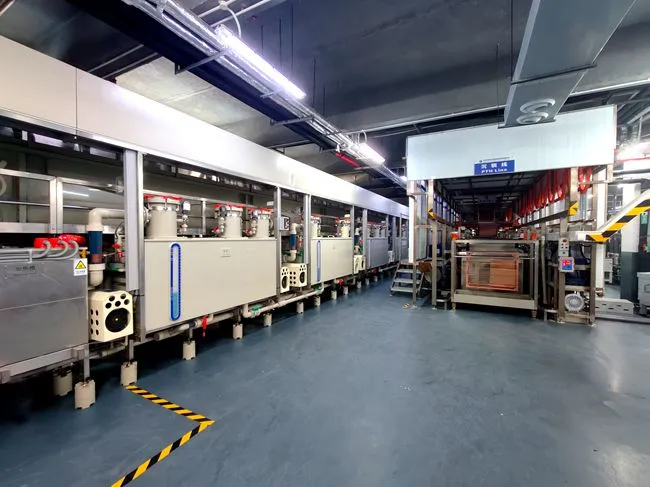The Stages of Turnkey PCB Assembly
Design and Engineering
The turnkey PCB assembly process begins with the design and engineering phase. This crucial stage sets the foundation for the entire project. Expert engineers work closely with clients to refine designs, optimize for manufacturability, and ensure compliance with industry standards. Advanced Design for Manufacturing (DFM) and Design for Assembly (DFA) techniques are employed to minimize potential issues and reduce costs.
During this phase, engineers utilize cutting-edge software tools to simulate and analyze designs. They consider factors such as signal integrity, thermal management, and electromagnetic compatibility. For high-performance applications like 5G technology or automotive electronics, specialized design considerations are implemented to meet stringent requirements for impedance control and high-density layouts.
PCB Fabrication
Once the design is finalized, the PCB fabrication process begins. This stage involves transforming the digital design into a physical board. Modern turnkey assembly providers leverage state-of-the-art manufacturing facilities equipped with advanced technologies like LDI (Laser Direct Imaging) for precise layer alignment and vacuum lamination for superior layer bonding.
The fabrication process can accommodate a wide range of board complexities, from simple double-layer boards to sophisticated multi-layer designs with up to 48 layers. Advanced capabilities such as blind and buried vias, micro vias, and controlled impedance traces are utilized to meet the demands of high-density, high-performance electronics. Rigorous in-process quality checks, including AOI (Automated Optical Inspection) and electrical testing, ensure that each board meets the specified requirements before moving to the assembly stage.
Component Sourcing and Management
A critical aspect of turnkey PCB assembly is the sourcing and management of electronic components. This process involves procuring all necessary parts, from resistors and capacitors to complex integrated circuits. Turnkey providers leverage their industry relationships and purchasing power to source components efficiently and cost-effectively.
Component management goes beyond simple procurement. It includes verifying part authenticity to prevent counterfeit components, managing inventory to ensure availability, and implementing just-in-time delivery systems to optimize production flow. Advanced turnkey providers also offer BOM (Bill of Materials) optimization services, suggesting alternative components that may offer better performance, availability, or cost-effectiveness without compromising the design integrity.
The Assembly Process in Turnkey PCB Manufacturing
Surface Mount Technology (SMT) Assembly
Surface Mount Technology (SMT) is the cornerstone of modern PCB assembly. This process involves placing and soldering components onto the surface of the PCB. Advanced SMT lines are equipped with high-speed pick-and-place machines capable of accurately positioning thousands of components per hour. These machines use computer vision systems and precision robotics to ensure exact component placement.
The SMT process typically involves several key steps:
1. Solder Paste Application: A precise amount of solder paste is applied to the board using stencil printing technology.
2. Component Placement: SMT machines pick up components from reels or trays and place them onto the board with high accuracy.
3. Reflow Soldering: The board passes through a reflow oven where the solder paste melts and forms solid connections between components and the board.
4. Inspection: Automated optical inspection (AOI) systems check for proper component placement and solder joint quality.
For complex assemblies, multiple SMT passes may be required to accommodate components on both sides of the board or to handle a wide range of component sizes and types.
Through-Hole Assembly
While SMT dominates modern PCB assembly, Turnkey PCB Assembly solutions also recognize that through-hole technology still plays a crucial role, especially for components that require stronger mechanical connections or for certain types of connectors and high-power components. In through-hole assembly, component leads are inserted through holes in the PCB and soldered on the opposite side.
Through-hole assembly can be performed manually for low-volume production or specialized applications. However, for higher volumes, automated insertion machines are used to place through-hole components quickly and accurately. The soldering process for through-hole components typically involves wave soldering, where the bottom of the board passes over a wave of molten solder, or selective soldering for more precise control.
Mixed Technology Assembly
Many modern PCBs require a combination of SMT and through-hole technologies. This mixed technology approach allows for the optimal selection of components and assembly methods based on the specific requirements of each part of the circuit. Managing mixed technology assemblies requires careful planning of the assembly sequence and specialized equipment capable of handling both SMT and through-hole processes efficiently.
Quality Assurance and Testing in Turnkey PCB Assembly
In-Process Quality Control
Quality assurance in turnkey PCB assembly is not a single step but an ongoing process integrated throughout the manufacturing workflow. In-process quality control measures are implemented at various stages to catch and correct issues early, preventing defects from propagating through the production line.
Key in-process quality control measures include:
- Automated Optical Inspection (AOI): High-resolution cameras and advanced image processing algorithms inspect boards for defects such as missing components, incorrect placements, or solder bridging.
- X-ray Inspection: For components with hidden solder joints, such as Ball Grid Arrays (BGAs), X-ray systems provide visibility into areas that cannot be inspected visually.
- Solder Paste Inspection (SPI): This process checks the quality and quantity of solder paste application before component placement, ensuring proper solder joint formation.
These automated inspection systems are complemented by manual inspections performed by trained technicians, especially for complex or critical assemblies.
Functional Testing
Functional testing is a crucial final step in the turnkey PCB assembly process. This stage verifies that the assembled PCB performs its intended functions correctly. The complexity of functional testing can vary widely depending on the nature of the product, from simple continuity checks to comprehensive performance evaluations under various operating conditions.
Advanced turnkey providers offer customized functional testing solutions, including:
- In-Circuit Testing (ICT): This method uses a bed-of-nails fixture to access test points on the PCB, allowing for rapid testing of individual components and connections.
- Flying Probe Testing: A more flexible alternative to ICT, flying probe testers use movable probes to access test points without the need for custom fixtures.
- Boundary Scan Testing: Also known as JTAG testing, this method is particularly useful for testing complex digital circuits and programmable devices.
- Environmental Testing: Simulating various environmental conditions (temperature, humidity, vibration) to ensure the PCB performs reliably under expected operating conditions.
The combination of these testing methodologies ensures that only fully functional and high-quality PCBs are delivered to the client.
Documentation and Traceability
A comprehensive turnkey PCB assembly process includes thorough documentation at every stage. This documentation serves multiple purposes, including quality assurance, regulatory compliance, and continuous improvement of the manufacturing process.
Key aspects of documentation and traceability include:
- Component Traceability: Tracking the origin and batch information of all components used in the assembly.
- Process Parameters: Recording critical parameters such as reflow profiles, machine settings, and inspection results.
- Test Results: Maintaining detailed records of all testing procedures and outcomes.
- Revision Control: Managing and documenting design changes and their implementation in the production process.
This comprehensive approach to documentation and traceability not only ensures quality and compliance but also facilitates troubleshooting and continuous improvement of the manufacturing process.
Conclusion
Understanding the full turnkey PCB assembly workflow is crucial for businesses looking to optimize their electronic product development and manufacturing processes. From initial design and engineering to final testing and quality assurance, each stage of the turnkey process plays a vital role in ensuring the production of high-quality, reliable PCBs. By leveraging advanced technologies, rigorous quality control measures, and comprehensive documentation practices, turnkey PCB assembly providers can deliver superior results while reducing time-to-market and overall production costs.
As electronics continue to evolve, with increasing demands for miniaturization, higher performance, and greater reliability, the importance of a well-executed turnkey PCB assembly process becomes even more pronounced. Companies that partner with experienced turnkey providers gain access to cutting-edge technologies and expertise, enabling them to stay competitive in rapidly advancing markets.
FAQ
What are the main advantages of turnkey PCB assembly?
Turnkey PCB assembly offers several benefits, including streamlined production, reduced costs, consistent quality, and faster time-to-market. By handling the entire process from design to final testing, turnkey providers can optimize each stage and ensure seamless integration between different phases of production.
How does turnkey PCB assembly handle complex designs?
Advanced turnkey providers are equipped to handle complex designs through high-density stack-ups (up to 48 layers), fine pitch components, and advanced manufacturing techniques like blind and buried vias. They also employ rigorous DFM and DFA processes to optimize designs for manufacturability and reliability.
Experience Excellence in Turnkey PCB Assembly | Ring PCB
At Ring PCB, we bring over 17 years of expertise to your turnkey PCB assembly projects. Our state-of-the-art facility, equipped with advanced LDI laser exposure and vacuum lamination systems, ensures precision manufacturing for even the most complex designs. We offer comprehensive solutions from PCB fabrication to full assembly, backed by rigorous quality control measures including X-ray inspection and AOI testing. Experience the difference of a truly integrated, one-stop PCB manufacturing partner. Contact us at [email protected] to elevate your next project with our turnkey PCB assembly services.
References
1. Johnson, M. (2023). "Advanced Techniques in Turnkey PCB Assembly". Journal of Electronics Manufacturing, 45(2), 112-128.
2. Smith, A. & Brown, B. (2022). "Quality Assurance Methodologies in Modern PCB Production". International Conference on Electronics Assembly, pp. 78-92.
3. Lee, C. et al. (2021). "Optimizing Component Sourcing Strategies for Turnkey PCB Assembly". Supply Chain Management in Electronics, 33(4), 201-215.
4. Garcia, R. (2023). "Innovations in High-Density PCB Fabrication for 5G Applications". IEEE Transactions on Advanced Packaging, 46(3), 355-370.
5. Wilson, E. (2022). "Environmental Considerations in PCB Manufacturing and Assembly". Green Electronics Forum Proceedings, pp. 145-160.






